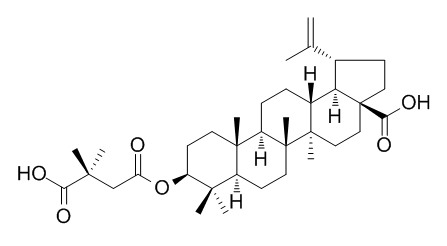Bevirimat
Bevirimat is a HIV-1 maturation inhibitor.
Inquire / Order:
manager@chemfaces.com
Technical Inquiries:
service@chemfaces.com
Tel:
+86-27-84237783
Fax:
+86-27-84254680
Address:
1 Building, No. 83, CheCheng Rd., Wuhan Economic and Technological Development Zone, Wuhan, Hubei 430056, PRC
Providing storage is as stated on the product vial and the vial is kept tightly sealed, the product can be stored for up to
24 months(2-8C).
Wherever possible, you should prepare and use solutions on the same day. However, if you need to make up stock solutions in advance, we recommend that you store the solution as aliquots in tightly sealed vials at -20C. Generally, these will be useable for up to two weeks. Before use, and prior to opening the vial we recommend that you allow your product to equilibrate to room temperature for at least 1 hour.
Need more advice on solubility, usage and handling? Please email to: service@chemfaces.com
The packaging of the product may have turned upside down during transportation, resulting in the natural compounds adhering to the neck or cap of the vial. take the vial out of its packaging and gently shake to let the compounds fall to the bottom of the vial. for liquid products, centrifuge at 200-500 RPM to gather the liquid at the bottom of the vial. try to avoid loss or contamination during handling.
Pol J Microbiol.2021, 70(1):117-130.
J Clin Med.2022, 11(13):3662.
Nutrients.2024, 16(19):3266.
Environ Toxicol.2024, 39(4):2417-2428.
Analytical sci. & Tech2016, 186-193
J Pain Res.2022, 15:3469-3478.
Phytochem Anal.2022, doi: 10.1002
J Ethnopharmacol.2023, 317:116789.
Nutr Res Pract.2023, 17(4):670-681.
Pest Manag Sci.2019, 75(9):2530-2541
Related and Featured Products
Antimicrob Agents Chemother. 2007 Sep;51(9):3063-6.
Safety and pharmacokinetics of Bevirimat (PA-457), a novel inhibitor of human immunodeficiency virus maturation, in healthy volunteers.[Pubmed:
17576843 ]
Bevirimat (BVM; formerly known as PA-457) is a novel inhibitor of human immunodeficiency virus (HIV) maturation that is being developed for the treatment of HIV infection.
METHODS AND RESULTS:
The pharmacokinetics of this agent in healthy male volunteers were studied in a randomized, double-blind study in which the participants received single oral doses of placebo (n = 8) or escalating doses of BVM at 25, 50, 100, or 250 mg (n = 6 per dose); escalation was performed only after the pharmacokinetics and safety of the preceding dose had been evaluated. Plasma was collected over 480 h after dosing and urine was collected over 48 h after dosing for determination of the values of pharmacokinetic parameters. BVM was well absorbed after oral administration, with peak plasma concentrations being achieved 1 to 3 h after dosing. The half-life was 60 to 80 h. The exposure assessed by determination of the peak concentration and the area under the concentration-time curve was dose proportional. Single oral doses of BVM were well tolerated: there were no dose-limiting toxicities, and no serious adverse events were reported.
CONCLUSIONS:
These findings suggest that that BVM offers a favorable pharmacokinetic profile, with predictable pharmacokinetics following the oral administration of single doses. The long half-life of BVM may facilitate once-daily dosing.
J Virol. 2011 Feb;85(4):1420-8.
HIV-1 maturation inhibitor bevirimat stabilizes the immature Gag lattice.[Pubmed:
21106735]
Maturation of nascent virions, a key step in retroviral replication, involves cleavage of the Gag polyprotein by the viral protease into its matrix (MA), capsid (CA), and nucleocapsid (NC) components and their subsequent reorganization. Bevirimat (BVM) defines a new class of antiviral drugs termed maturation inhibitors. BVM acts by blocking the final cleavage event in Gag processing, the separation of CA from its C-terminal spacer peptide 1 (SP1). Prior evidence suggests that BVM binds to Gag assembled in immature virions, preventing the protease from accessing the CA-SP1 cleavage site.
METHODS AND RESULTS:
To investigate this hypothesis, we used cryo-electron tomography to examine the structures of (noninfectious) HIV-1 viral particles isolated from BVM-treated cells. We find that these particles contain an incomplete shell of density underlying the viral envelope, with a hexagonal honeycomb structure similar to the Gag lattice of immature HIV but lacking the innermost, NC-related, layer.
CONCLUSIONS:
We conclude that the shell represents a remnant of the immature Gag lattice that has been processed, except at the CA-SP1 sites, but has remained largely intact. We also compared BVM-treated particles with virions formed by the mutant CA5, in which cleavage between CA and SP1 is also blocked.
Here, we find a thinner CA-related shell with no visible evidence of honeycomb organization, indicative of an altered conformation and further suggesting that binding of BVM stabilizes the immature lattice. In both cases, the observed failure to assemble mature capsids correlates with the loss of infectivity.



